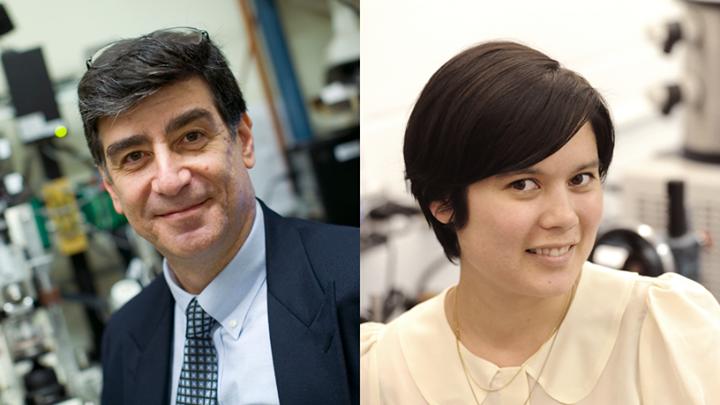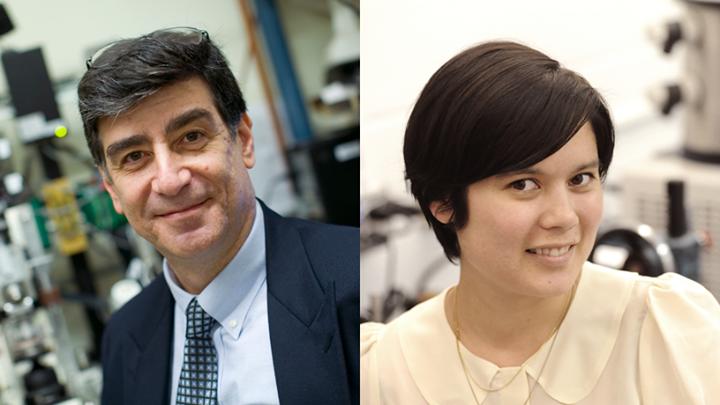
Credit: Ateshian: photo by Matt Lenz/Columbia Engineering Myers: photo by Eileen Barroso/Columbia Engineering
Two mechanical engineering professors have won top honors from the American Society of Mechanical Engineers (ASME). Gerard Ateshian, Andrew Walz Professor of Mechanical Engineering and professor of biomedical engineering, was awarded the 2017 H.R. Lissner Medal for his "outstanding contributions to theoretical formulations and experimental investigations of cartilage mechanics and tissue engineering, and for pivotal contributions to the implementation and dissemination of open-source finite element computational tools for the biomechanical analysis of living tissues." His research is focused on developing better modalities for the treatment of osteoarthritis, such as stronger engineered cartilage for resurfacing knee, hip, and shoulder joints. Kristin Myers, associate professor of mechanical engineering, won the Y.C. Fung Young Investigator Award for her "pioneering efforts in maternal and fetal health, resulting in a body of experimental and modeling work that drives the area of reproductive biomechanics and the larger field of soft tissues biomechanics." She studies the mechanics of the uterus and cervix to understand how to prevent premature births. The awards will be presented in June at the Summer Biomechanics, Bioengineering, and Biotransport Conference in Tucson, Arizona
Ateshian directs the Musculoskeletal Biomechanics Laboratory, which focuses on soft tissue mechanics, with an emphasis on cartilage mechanics, lubrication, and tissue engineering, and the formulation of growth theories for biological tissues. His group has demonstrated that the friction coefficient of cartilage is dependent on the pressurization of its interstitial fluid, resolving an open issue in the field of cartilage tribology and emphasizing that preserving the integrity of cartilage is critical to maintaining low friction. In 2000, in collaboration with Biomedical Engineering Professor Clark Hung, he published the first study to demonstrate that dynamic loading significantly enhances cartilage construct mechanical properties, thus translating their findings on cartilage mechanics to the field of functional cartilage tissue engineering. More recently, his group has engineered cartilage constructs as large as human articular layers, with mechanical properties as good or better than small constructs, using a combination of computational and experimental tools for enhancing nutrient supply. He is also working with Jeffrey Weiss, professor of bioengineering at the University of Utah, to develop open-source computational tools that facilitate the modeling of tissue mechanics, transport, and growth processes. These tools enable researchers to better understand structure-function relationships in biological tissues and optimize the design of tissue engineering modalities and protocols.
"We are now using this growth framework to optimize the culture conditions of large engineered articular layer constructs for the purpose of replacing entire osteoarthritic joint surfaces with cartilage grown in vitro," Ateshian says. "It's great to have our work recognized by ASME, and I am very honored to receive the H.R. Lissner Medal."
Kristin Myers' research focuses on characterizing the mechanical performance of the soft tissues that support the fetus during pregnancy and elucidating the causes of preterm birth related to premature tissue remodeling and tissue over-distension. Her Soft Tissue Lab investigates the structure-mechanical property relationships in cervical and uterine tissue through rigorous mechanical testing protocols that capture its biological complexity. Her group also builds anatomical simulation models of the female abdomen during pregnancy using ultrasound imaging data and finite element methods. These computer-based finite element models simulate the anatomical changes that occur based on applied mechanical loading and integrated soft tissue structure-mechanical property data. Through these microstructurally informed biomechanical models, she hopes to identify the physical underpinnings of clinically observed mechanical dysfunction in pregnancy, such as premature cervical shortening, uterine over-distension and preterm labor, and preterm premature rupture of fetal membranes.
"We are currently collaborating with a clinical research team in the Department of Obstetrics and Gynecology at Columbia University Medical Center," Myers says. "Our aim is to build a fast, flexible, and reliable computational framework to assess the patient-specific biomechanical environment of pregnancy to better inform clinical decisions. I am deeply honored to win ASME's Y.C. Fung Young Investigator Award, and I am thrilled to raise the visibility of reproductive biomechanics in the engineering and medical fields."
###
LINKS:
https://www.asme.org/
http://mbl.me.columbia.edu/gerard-ateshian
http://kristinmyerscolumbia.com/
http://mbl.me.columbia.edu/gerard-ateshian
https://kristinmyerscolumbia.com/
http://www.cumc.columbia.edu/
Media Contact
Holly Evarts
[email protected]
212-854-3206
@CUSEAS
http://www.engineering.columbia.edu/
############
Story Source: Materials provided by Scienmag





